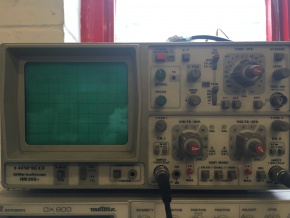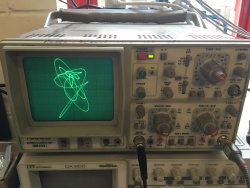Electronics/HM203-7: Difference between revisions
No edit summary |
m (add category) |
||
| (4 intermediate revisions by the same user not shown) | |||
| Line 1: | Line 1: | ||
[[Category:Tools_and_Equipment]] | |||
[[Category:Electronics]] | |||
{{Equipment | {{Equipment | ||
| title = Oscilloscope | | title = Oscilloscope | ||
| Line 24: | Line 26: | ||
* 100ms to 0.2us horizontal (x10 to give 20ns/div) | * 100ms to 0.2us horizontal (x10 to give 20ns/div) | ||
* Component tester | * Component tester | ||
[[File:HamegHM203-7-x-y-Pattern.JPG|250px|thumb|right|Pattern created using X-Y mode using 2 signal generator inputs]] | |||
* X-Y mode for Lissajous figure and drawing [https://www.youtube.com/watch?v=rtR63-ecUNo funny images with audio!] | * X-Y mode for Lissajous figure and drawing [https://www.youtube.com/watch?v=rtR63-ecUNo funny images with audio!] | ||
* Scope 1 issues: [31 March 2016] Functional. CH1 10% low on vertical, CH2 10% low on vertical, Horizontal about 5% high, confirmed against cal point and a precision v ref. | * Scope 1 issues: [31 March 2016] Functional. CH1 10% low on vertical, CH2 10% low on vertical, Horizontal about 5% high, confirmed against cal point and a precision v ref. | ||
| Line 30: | Line 33: | ||
* Owner: Fligg, labelled scope 1 | * Owner: Fligg, labelled scope 1 | ||
* Owner: TBD, labelled scope 2 | * Owner: TBD, labelled scope 2 | ||
== Calibration == | == Calibration == | ||
| Line 41: | Line 46: | ||
== Safety == | == Safety == | ||
[[Electronics/safety|You must read the safety documentation in this link before using this equipment.]] | |||
== Useful References == | == Useful References == | ||
Latest revision as of 12:07, 19 June 2017
 | |
| Analogue oscilloscope | |
| Equipment Information | |
|---|---|
| Status | Unknown |
| Manufacturer | Hameg |
| Model | HM203-7 |
| Hackspace Information | |
| Induction Required | Yes |
| Induction Information | Here |
| Card RFID Enabled | No |
| Owner | Hackspace & Members & Fligg |
| [More Info] | |
The Basics
An oscilloscope is a piece of electrical test equipment which allows you to visually see an electrical signal shown on a display. We have two Hameg HM203-7 oscilloscopes at the hackspace.
Specification
A basic oscilloscope specification is given below:
- Analogue Cathode ray tube (CRT)
- Bandwidth: 20MHz
- 2 channel + Ext trigger (2.5:1 to 12.5v/div)
- 5v to 5mv vertical (x5 giving 1mv sensitivity)
- 100ms to 0.2us horizontal (x10 to give 20ns/div)
- Component tester
- X-Y mode for Lissajous figure and drawing funny images with audio!
- Scope 1 issues: [31 March 2016] Functional. CH1 10% low on vertical, CH2 10% low on vertical, Horizontal about 5% high, confirmed against cal point and a precision v ref.
- Scope 2 Issues: [31 March 2016] Functional. CH1 10% low on vertical, CH2 10% low on vertical, Horizontal about 5% low, confirmed against cal point and a precision v ref.
- Manual TBD
- Owner: Fligg, labelled scope 1
- Owner: TBD, labelled scope 2
Calibration
The spaces oscilloscopes will NOT normally have a calibration certificate. Most will be well outside their calibration date. Having said that it is common to perform a basic oscilloscopes calibration check before each use against a known calibration source to confirm it is suitable for use. Most oscilloscopes have a calibration signal output point on the front panel. Some have rear panel outputs.
Induction
Ask on the mailing list for volunteers to demonstrate the use of any of the test equipment.
Safety
You must read the safety documentation in this link before using this equipment.
